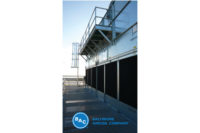
Closed circuit cooling towers completely isolate process cooling fluid from the atmosphere. This is accomplished by combining heat rejection equipment with a heat exchanger in a closed circuit tower (see Figure 2). A closed loop system protects the quality of the process fluid, reduces system maintenance, and provides operational flexibility at a slightly higher initial cost.
When deciding which system is best for an application, several factors should be considered.

PERFORMANCE
If an application must produce full capacity throughout the year, maintaining a clean, reliable system loop is critical. Isolating the process fluid in a closed loop system prevents airborne contaminants from entering and fouling the system. Sustaining optimum performance in an open loop system will require regular maintenance to assure similar efficiency. High-efficiency chillers and heat exchangers rely on clean process water to function properly and are significantly impacted by even small amounts of fouling.EXPENSE
The initial equipment cost of an open loop system will be less than a comparably sized closed loop system, since the open system does not include the intermediate heat exchanger component. However, the higher first cost of a closed loop system will be paid back during years of operation through the following savings:MAINTENANCE
Since the process fluid of a closed loop system is completely isolated from the environment, routine maintenance is only required on the heat rejection equipment itself. The need to shut down the system periodically to clean the heat exchanger is dramatically reduced, if not entirely eliminated. Providing clean process fluid to the system will extend the life of other components in the system (condenser bundles, compressors, etc.).WATER TREATMENT
Maintaining proper process fluid quality in a system may involve several steps, such as chemical treatment, filtration equipment, and the addition of clean make-up water. A closed circuit cooling tower can provide the following advantages over an open cooling tower:OPERATIONAL FLEXIBILITY
Closed circuit towers allow for the following modes of operation not possible with open towers:
CLOSED CIRCUIT TOWER vs.
OPEN TOWER/HEAT EXCHANGER
Sometimes, an open cooling tower is paired with a heat exchanger (see Figure 3) to capture some of the benefits of closed loop cooling. Choosing closed circuit cooling towers over this open tower/heat exchanger combination may still be a better choice for the following reasons:
These guidelines provide some general information to help decide whether a closed circuit cooling tower is better suited for a particular application than an open tower, with or without a heat exchanger. For additional assistance with a project, contact your local cooling tower representative.
Excerpted and reprinted with permission from the Baltimore Aircoil Company (BAC) Product & Application Handbook. For more information, visit www.baltimoreaircoil.com.
Publication date: 05/29/2006






